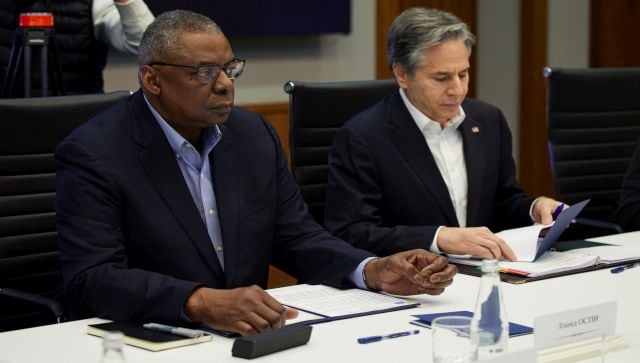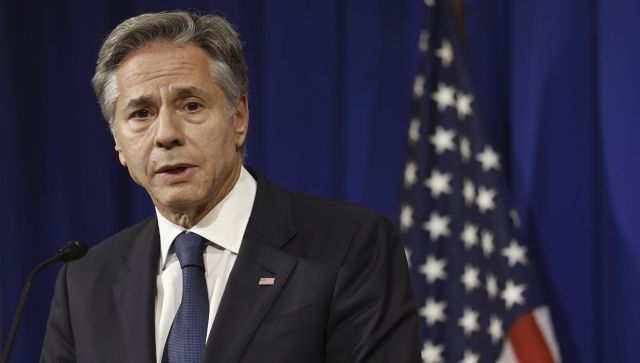US Secretary of State Antony Blinken is a busy man. After concluding a whirlwind visit to West Asia (his second since the Israel-Hamas war began on 7 October), he headed to Japan and South Korea. His next stop is India. And he is not coming alone. Blinken is accompanied by US Secretary of Defence Lloyd Austin. On their agenda is the 2+2 Ministerial dialogue to be held on 10 November, Friday. The two American leaders will meet their Indian counterparts, External Affairs Minister S Jaishankar and Defence Secretary Rajnath Singh. They will also hold bilateral meetings. Announcing the visit last week, the US State Department said that Blinken would travel to Tel Aviv, Amman, Tokyo, Seoul and New Delhi from November 2 to 10 November. “The Secretary will then travel to New Delhi to participate in the
2+2 Ministerial Dialogue , joined by Secretary of Defence Lloyd J Austin III. The delegation will meet with Minister for External Affairs Subrahmanyam Jaishankar, Minister of Defence Rajnath Singh, and other senior Indian officials to discuss both bilateral and global concerns and developments in the Indo-Pacific,” it said. Blinken last visited India in March for the G20 foreign ministers’ meeting. The latest trip with Austin is the first by senior American leadership since the Israel-Hamas war began. We take a look at what this meeting is and
what will be discussed . What is the 2+2 dialogue? The 2+2 ministerial dialogue is a format which involves the meeting of foreign and defence ministers of India and its strategic partners with their counterparts on issues of strategy and security. It was launched in 2018 to boost defence cooperation and align policy objectives in the Indo-Pacific region. The dialogue is held to build strong relationships in a fast-changing geopolitical environment by understanding each other’s strategic choices and concerns by taking into account the political factors of both sides, according to a report in The Indian Express. The meetings involve taking stock of a range of key issues like defence, nuclear cooperation, space, cyber security, and visas. [caption id=“attachment_13366202” align=“alignnone” width=“640”] Defence Minister Rajnath Singh and External Affairs Minister S Jaishankar will host the two US Cabinet ministers. File photo/Reuters[/caption] India has these meetings with its four key allies, the US, Russia, Australia and Japan. The US is India’s most important (and oldest) 2+2 dialogue partner. The first such meeting between the two countries was held during the Trump administration in September 2018. Then-Secretary of State Michael Pompeo and then-Secretary of Defence James Mattis met the late Sushma Swaraj and then-Defence Minister Nirmala Sitharaman in New Delhi. The meeting on Friday will be the fifth such dialogue. What will be discussed at the latest India-US 2+2 dialogue? The meeting comes at a time when the world is divided over geopolitical tensions sparked by the Israel-Hamas war and the Russia-Ukraine conflict. However, officials say its main focus is on security challenges in the Indo-Pacific and concerns over China, according to a report in Reuters. China and the larger Indo-Pacific will be the “key focus points”, an Indian government official aware of the agenda was quoted as saying by Reuters. China and its growing assertiveness in the region is a big concern for India, the US and other world powers, which have been discussing the need to ensure a free Indo-Pacific. This comes at a time when both New Delhi and Washington have tense ties with Beijing. [caption id=“attachment_13366212” align=“alignnone” width=“640”]
 US Secretary of State Antony Blinken (right) and US Defence Secretary Lloyd Austin will also hold bilaterals with their Indian counterparts. File photo/Reuters[/caption]
The Israel-Hamas war and the Ukraine-Russia conflict are also likely to come up in talks. The conflicts do not have a direct impact on the ties between India and the US. But while the US is Israel’s biggest ally and has backed Ukraine, India has treaded the diplomatic middle ground without picking sides in both wars. These geopolitical developments influence strategic relationships between nations. At the India-US 2+2 dialogue, the ministers “will take the opportunity to progress the futuristic roadmap for the India-US partnership as envisioned by Prime Minister Shri Narendra Modi and President Joseph Biden, in their discussions in June and September this year,” the MEA said in a statement. The meeting will enable a high-level review of progress in “cross-cutting aspects of defence and security cooperation, technology value chain collaborations and people-to-people ties”, it added. According to the Indian government official, defence collaboration, including joint development of defence equipment, would also be discussed. India is acquiring 31
MQ-9B Reaper drones from the US and General Electrics and Hindustan Aeronautics Limited have signed an agreement to manufacture
GE-414 jet engines in India. The two countries are also working on deals for semiconductor manufacturing. The discussions would pick up the threads from
PM Modi’s successful visit to Washington in June and Biden’s trip to New Delhi for the G20 summit in September, officials said, according to Reuters. India’s diplomatic spat with Canada over the killing of
Khalistani terrorist Hardeep Singh Nijjar is not expected to affect the dialogue even though Washington has pressured New Delhi to cooperate with Ottawa in the murder investigation, the report says. US officials were moving swiftly to deepen ties with India while pledging support for an investigation into the June killing on Canadian soil, an American official aware of the Indo-Pacific policy said. With inputs from agencies
US Secretary of State Antony Blinken (right) and US Defence Secretary Lloyd Austin will also hold bilaterals with their Indian counterparts. File photo/Reuters[/caption]
The Israel-Hamas war and the Ukraine-Russia conflict are also likely to come up in talks. The conflicts do not have a direct impact on the ties between India and the US. But while the US is Israel’s biggest ally and has backed Ukraine, India has treaded the diplomatic middle ground without picking sides in both wars. These geopolitical developments influence strategic relationships between nations. At the India-US 2+2 dialogue, the ministers “will take the opportunity to progress the futuristic roadmap for the India-US partnership as envisioned by Prime Minister Shri Narendra Modi and President Joseph Biden, in their discussions in June and September this year,” the MEA said in a statement. The meeting will enable a high-level review of progress in “cross-cutting aspects of defence and security cooperation, technology value chain collaborations and people-to-people ties”, it added. According to the Indian government official, defence collaboration, including joint development of defence equipment, would also be discussed. India is acquiring 31
MQ-9B Reaper drones from the US and General Electrics and Hindustan Aeronautics Limited have signed an agreement to manufacture
GE-414 jet engines in India. The two countries are also working on deals for semiconductor manufacturing. The discussions would pick up the threads from
PM Modi’s successful visit to Washington in June and Biden’s trip to New Delhi for the G20 summit in September, officials said, according to Reuters. India’s diplomatic spat with Canada over the killing of
Khalistani terrorist Hardeep Singh Nijjar is not expected to affect the dialogue even though Washington has pressured New Delhi to cooperate with Ottawa in the murder investigation, the report says. US officials were moving swiftly to deepen ties with India while pledging support for an investigation into the June killing on Canadian soil, an American official aware of the Indo-Pacific policy said. With inputs from agencies
US Secretary of State Antony Blinken and Defence Secretary Lloyd J Austin will be in New Delhi for the India-US 2+2 ministerial dialogue on Friday. They will meet their counterparts, External Affairs Minister S Jaishankar and Defence Minister Rajnath Singh. What’s on the agenda?
Advertisement
End of Article


)

)
)
)
)
)
)
)
)



